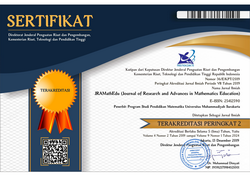Mathematical Creative Thinking Ability of Junior High School Students in Solving Open-Ended Problem
Herwinanda Trisnaning Damayanti(1), Sumardi Sumardi(2*)(1) Department of Mathematics Education, Universitas Muhammadiyah Surakarta
(2) Department of Mathematics Education, Universitas Muhammadiyah Surakarta
(*) Corresponding Author
Abstract
The study aims to describe the ability of mathematical creative thinking on the aspects of fluency, flexibility, and originality in solving open-ended problem of Linear Equations with One Variable. The subjects are 7th grade students of one private junior high school in Surakarta, Central Java, Indonesia. The data was collected by the test, interview, and documentation. The method of data validation was used triangulation, i.e. techniques and resources. The analysis technique of the data was used an interactive method that consists of the reduction, presentation, and conclusion. The result of the research shows that the fluency aspect achieved by the students ability to mention the possibility of other answers. Then, the flexibility aspect is showed by the students use different method to solve the problem, or at least use the appropriate method. The originality aspect is showed by the students‘ ability to make the problem which are rarely found by other students.
Keywords
Full Text:
PDFReferences
Akgul, S., &Kahveci, N.G. 2016. A study on the development of mathematics creativity scale. Eurasian Journal of Educational Research, 6(2), 57-76.
Albert, L.R., &Kim,R. 2013. Developing Creativity Through Collaborative Problem Solving. Journal of Mathematics Education at Teachers College, 4(2), 32-38.
Anggraeny, D.B., Siswono, T.Y. (2013). Identifikasi Tingkat Berpikir Kreatif Siswa Menggunakan Multiple Solution Task (MST). Jurnal Math Edunesa, 1(2)
Bahar, K.A., Maker, C.J. 2011. Exploring the Relationship Between Mathematical Creativity and Mathematical Achievment. Asia-Pasific Journal of Gifted and Talented Education, 3(1), 33-48.
Beetlestone, F. 2011. Strategi Pembelajaran untuk Melesatkan Kreatifitas Siswa. Diterjemahkan oleh: Narulita Yusron. Bandung: Nusa Media.
Briggs, M., & Sue, D. 2008. Creavite Teaching Mathematics. New York: Routledge.
Fardah, D.K. 2012. Analisis Proses dan Kemampuan Berpikir Kreatif Siswa dalam Matematika Melalui Tugas Open-Ended. Jurnal Kreano, 3(2).
Fatah, A., et al. 2016. Open-Ended Approach: An Effort In Cultivating Students’ Mathematical Creative Thinking Ability and Self-Esteem In Mathematics.Journal on Mathematics Education, 7(1), 11-20.
Ibrahim &Suparni. 2009. StrategiPembelajaranMatematika. Yogyakarta: Teras.
Kemendikbud. 2006. Survei Internasional PISA. Diakses 3 Oktober 2016: (http://litbang.kemdikbud.go.id/index.php/survei-internasional-pisa).
Masruroh, R., Sijado, I., & Sari, D.R. 2015. Kategori Berpikir Kreatif Siswa Kelas VII SMP Negeri 1 Surakarta dalam Menyelesaikan Masalah Matematika pada Materi Pokok Himpunan. Jurnal Elektronik Pembelajaran Matematika, 3(3), 305-312.
Murni. 2013. Open Ended Approach in Learning to Improve Student Thinking Skill in Banda Aceh. International Journal of Independent Research and Studies, 2(2), 95-101.
Mursidik, E.M., Samsiyah, N., Rudyanto, H.E. 2015. Kemampuan Berpikir Kreatif dalam Memecahkan Masalah Matematika Open-Ended Ditinjau dari Tingkat Kemampuan Matematika pada Siswa Sekolah Dasar. Journal Pedagogia, 4(1), 23-33.
Putri, V.S.R., &Wijayanti, P. 2013. Identifikasi Tingkat Kemampuan Berpikir Kreatif (TKBK) Siswa dalam Menyelesaikan Soal Open Ended pada Materi Segiempat di Kelas VIII SMP. Jurnal Math Edunesa, 2(2).
Shimada, Shigeru & Jerry P. Becker. 1998. The Open-Ended Approach: A New Proposal for Teaching Mathematics. Virginia: National Council of Teachers of Mathematics.
Siswono, T.Y.E. 2011. Level of Student’s Creative Thinking in Classroom Mathematics. Journal Educational Research and Review, 6(7), 548-553.
Siswono, T.Y.E. 2015. Desain Tugas untuk Mengidentifikasi Kemampuan Berpikir Kreatif Siswa dalam Matematika. Diakses dari https://www.researchgate.net/publication/242735927_Desain_Tugas_untuk_Mengidentifikasi_kemampuan_berpikir_Kreatif_Siswa_dalam_Matematika
Sugiyono. 2012. Memahami Penelitian Kualitatif. Bandung: Alfabeta.
Article Metrics
Abstract view(s): 5449 time(s)PDF: 3921 time(s)
Refbacks
- There are currently no refbacks.







